Dust Monitors in JET with ITER-like Wall for Diagnosis of Mobilized Particles and Co-Deposited Layers
Abstract
1. Introduction
2. Materials and Methods
3. Results and Discussion
3.1. Morphology of Individual Particles
3.2. Small Particles and Co-Deposits
4. Conclusions
Author Contributions
Funding
Institutional Review Board Statement
Informed Consent Statement
Data Availability Statement
Conflicts of Interest
References
- Matthews, G.F.; Beurskens, M.; Brezinsek, S.; Groth, M.; Joffrin, E.; Loving, A.; Kear, M.; Mayoral, M.-L.; Neu, P.; Prior, P.; et al. JET ITER-like wall—Overview and experimental programme. Phys. Scr. 2011, T145, 014001. [Google Scholar] [CrossRef]
- Merola, M.; Escourbiac, F.; Raffray, R.; Chappuis, P.; Hirai, T.; Martin, A. Overview and status of ITER internal components. Fusion Eng. Des. 2014, 89, 890–895. [Google Scholar] [CrossRef]
- Brezinsek, S.; JET-EFDA Contributors. Plasma-surface interaction in the Be/W environment: Conclusions drawn from the JET-ILW for ITER. J. Nucl. Mater. 2015, 463, 11–21. [Google Scholar] [CrossRef]
- Widdowson, A.; Coad, J.; Alves, E.; Baron-Wiechec, A.; Barradas, N.; Brezinsek, S.; Catarino, N.; Corregidor, V.; Heinola, K.; Koivuranta, S.; et al. Overview of fuel inventory in JET with the ITER-like wall. Nucl. Fusion 2017, 57, 086045045. [Google Scholar] [CrossRef]
- Rubel, M.; Petersson, P.; Zhou, Y.; Coad, J.; Lungu, C.; Jepu, I.; Porosnicu, C.; Matveev, D.; Kirschner, A.; Brezinsek, S.; et al. Fuel inventory and deposition in castellated structures in JET-ILW. J. Nucl. Mater. 2003, 321, 313–316. [Google Scholar] [CrossRef]
- Mayer, M.; Krat, S.; Baron-Wiechec, A.; Gasparyan, Y.; Heinola, K.; Koivuranta, S.; Likonen, J.; Ruset, C.; de Saint-Aubin, G.; Widdowson, A.; et al. Erosion and deposition in the JET divertor during the second ITER-like wall campaign. Phys. Scr. 2017, T170, 014058. [Google Scholar] [CrossRef]
- Krat, S.; Mayer, M.; Baron-Wiechec, A.; Brezinsek, S.; Coad, P.; Gasparyan, Y.; Heinola, K.; Jepu, I.; Likonen, J.; Petersson, P.; et al. Comparison of erosion and deposition in JET divertor during the first three ITER-like wall campaigns. Phys. Scr. 2020, T171, 014059. [Google Scholar] [CrossRef]
- Heinola, K.; Widdowson, A.; Likonen, J.; Ahlgren, T.; Alves, E.; Ayres, C.F.; Baron-Wiechec, A.; Barradas, N.; Brezinsek, S.; Catarino, N.; et al. Experience on divertor fuel retention after two ITER-Like Wall campaigns. Phys. Scr. 2017, T170, 014063. [Google Scholar] [CrossRef]
- Dittrich, L.; Petersson, P.; Rubel, M.; Tran, T.T.; Widdowson, A.; Jepu, I.; Porosnicu, C.; Alves, E.; Catarino, N.; Contributors, J. Fuel retention and erosion-deposition on inner wall cladding tiles in JET-ILW. Phys. Scr. 2021, 96, 124071. [Google Scholar] [CrossRef]
- Widdowson, A.; Coad, J.P.; Zayachuk, Y.; Jepu, I.; Alves, E.; Catarino, N.; Corregidor, V.; Mayer, M.; Krat, S.; Likonen, J.; et al. Evaluation of tritium retention in plasma facing components during JET tritium operations. Phys. Scr. 2021, 96, 124075. [Google Scholar] [CrossRef]
- Baron-Wiechec, A.; Fortuna-Zaleśna, E.; Grzonka, J.; Rubel, M.; Widdowson, A.; Ayres, C.; Coad, J.P.; Hardie, C.; Heinola, K.; Matthews, G.F.; et al. First dust studies in JET with the ITER-Like Wall: Sampling, analysis and characterisation. Nucl. Fusion 2015, 55, 113033. [Google Scholar] [CrossRef]
- Fortuna-Zaleśna, E.; Grzonka, J.; Moon, S.; Rubel, M.; Petersson, P.; Widdowson, A.; Contributors, J.E.T. Fine metal dust particles on the wall probes from JET with the ITER-Like Wall. Phys. Scr. 2017, T170, 014038. [Google Scholar] [CrossRef]
- Fortuna-Zalesna, E.; Grzonka, J.; Rubel, M.; Garcia-Carrasco, A.; Widdowson, A.; Baron-Wiechec, A.; Ciupinski, L.; Contributors, J. Studies of dust from JET with the ITER-Like Wall: Composition and internal structure. Nucl. Mater. Energy 2017, 12, 582–587. [Google Scholar] [CrossRef]
- Fazinić, S.; Tadić, T.; Vukšić, M.; Rubel, M.; Petersson, P.; Fortuna-Zaleśna, E.; Widdowson, A. Ion micro-beam analysis of dust particles and co-deposits from JET with ITER-like wall. Anal. Chem. 2018, 90, 5744. [Google Scholar] [CrossRef]
- Fazinić, S.; Božičević-Mihalić, I.; Provatas, G.; Tadić, T.; Rubel, M.; Fortuna-Zaleśna, E.; Widdowson, A.; JET Contributors. Micro-analyses of dust particles generated in the JET tokamak with the ITER-like wall. Nucl. Fusion 2020, 60, 126031. [Google Scholar] [CrossRef]
- Rubel, M.; Widdowson, A.; Grzonka, J.; Fortuna-Zalesna, E.; Moon, S.; Petersson, P.; Ashikawa, N.; Asakura, N.; Hamaguchi, D.; Hatano, Y.; et al. Dust generation in tokamaks: Overview of beryllium and tungsten dust characterisation in JET with the ITER-like wall. Fusion Eng. Des. 2018, 136, 579. [Google Scholar] [CrossRef]
- Fortuna-Zaleśna, E.; Plociński, T.; Moon, S.W.; Petersson, P.; Rubel, M.; Widdowson, A.; Contributors, J.E.T. Dust generation and accumulation in JET-ILW: Mnorphology and stability of co-deposits on main plasma-facing components and wall probes. Phys. Scr. 2021, 96, 124038. [Google Scholar] [CrossRef]
- Winter, J. Dust in fusion devices–experimental evidence, possible sources and consequences. Plasma Phys. Control Fusion 1998, 40, 1201. [Google Scholar] [CrossRef]
- Rubel, M.; Cecconello, M.; Malmberg, J.; Sergienko, G.; Biel, W.; Drake, J.; Hedqvist, A.; Huber, A.; Philipps, V. Dust particles in controlled fusion devices: Morphology, observations in the plasma and influence on the plasma performance. Nucl. Fusion 2001, 41, 1087–1099. [Google Scholar] [CrossRef]
- Ivanova, D.; Rubel, M.; Philipps, V.; Freisinger, M.; Huang, Z.; Penkalla, H.; Schweer, B.; Sergienko, G.; Sundelin, P.; Wessel, E. Survey of dust formed in the TEXTOR tokamak: Structure and fuel retention. Phys. Scr. 2009, T138, 014025. [Google Scholar] [CrossRef]
- Balden, M.; Endstrasser, N.; Humrickhouse, P.; Rohde, V.; Rasinski, M.; Von Toussaint, U.; Elgeti, S.; Neu, R.; the ASDEX Upgrade Team. Collection strategy, inner morphology, and size distribution of dust particles in ASDEX Upgrade. Nucl. Fusion 2014, 54, 073010. [Google Scholar] [CrossRef]
- Sharpe, J.P.; Chappuis, P.; Petti, D.A. Characterisation of Tokamak Dust collected from Tore Supra. Fusion Technol. 2001, 39, 1061. [Google Scholar] [CrossRef]
- Jepu, I.; Matthews, G.; Widdowson, A.; Rubel, M.; Fortuna-Zalesna, E.; Zdunek, J.; Petersson, P.; Thompson, V.K.; Dinca, P.; Porosnicu, C.; et al. Beryllium melting and erosion on the upper dump plates in JET during three ITER-like wall campaigns. Nucl. Fusion 2019, 59, 086009. [Google Scholar] [CrossRef]
- Matthews, G.F.; Bazylev, B.; Baron-Wiechec, A.; Coenen, J.; Heinola, K.; Kiptily, V.; Maier, H.; Reux, C.; Riccardo, V.; Rimini, F.; et al. Melt damage to the JET ITER-like Wall and divertor. Phys. Scr. 2016, T167, 014070. [Google Scholar] [CrossRef]
- Rubel, M.; Widdowson, A.; Fortuna-Zaleśna, E.; Ayres, C.; Berry, M.; Burford, M.; Collins, S.; Macheta, P.; Contributors, J. Search for mobilised dust during operations with equipment for remote handling in JET with ITER-like wall. Phys. Scr. 2020, T171, 014048. [Google Scholar] [CrossRef]
- Coad, J.; Rubel, M.; Likonen, J.; Bekris, N.; Brezinsek, S.; Matthews, G.; Mayer, M.; Widdowson, A. Material migration and fuel retention studies during the JET carbon divertor campaigns. Fusion Eng. Des. 2018, 138, 78–108. [Google Scholar] [CrossRef]
- Otsuka, T.; Masuzaki, S.; Ashikawa, N.; Hatano, Y.; Asakura, Y.; Suzuki, T.; Isobe, K.; Hayashi, T.; Tokitani, M.; Oya, Y.; et al. Tritium retention characteristic in dust partciles in JET with ITER-like wall. Nucl. Mater. Energy 2018, 17, 279. [Google Scholar] [CrossRef]
- Otsuka, T.; Masuzaki, S.; Ashikawa, N.; Torikai, Y.; Hatano, Y.; Tokitani, M.; Oya, Y.; Asakura, N.; Hayashi, T.; Tanigawa, H.; et al. An overview of tritium retention in dust particles from the JET-ILW divertor. Phys. Scr. 2022, 97, 024008. [Google Scholar] [CrossRef]
- Mayer, M.; Möller, S.; Rubel, M.; Widdowson, A.; Charisopoulos, S.; Ahlgren, T.; Alves, E.; Apostolopoulos, G.; Barradas, N.P.; E Donnelly, S.; et al. Ion beam analysis of fusion plasma-facing materials and components: Facilities and research challenges. Nucl. Fusion 2019, 60, 025001. [Google Scholar] [CrossRef]
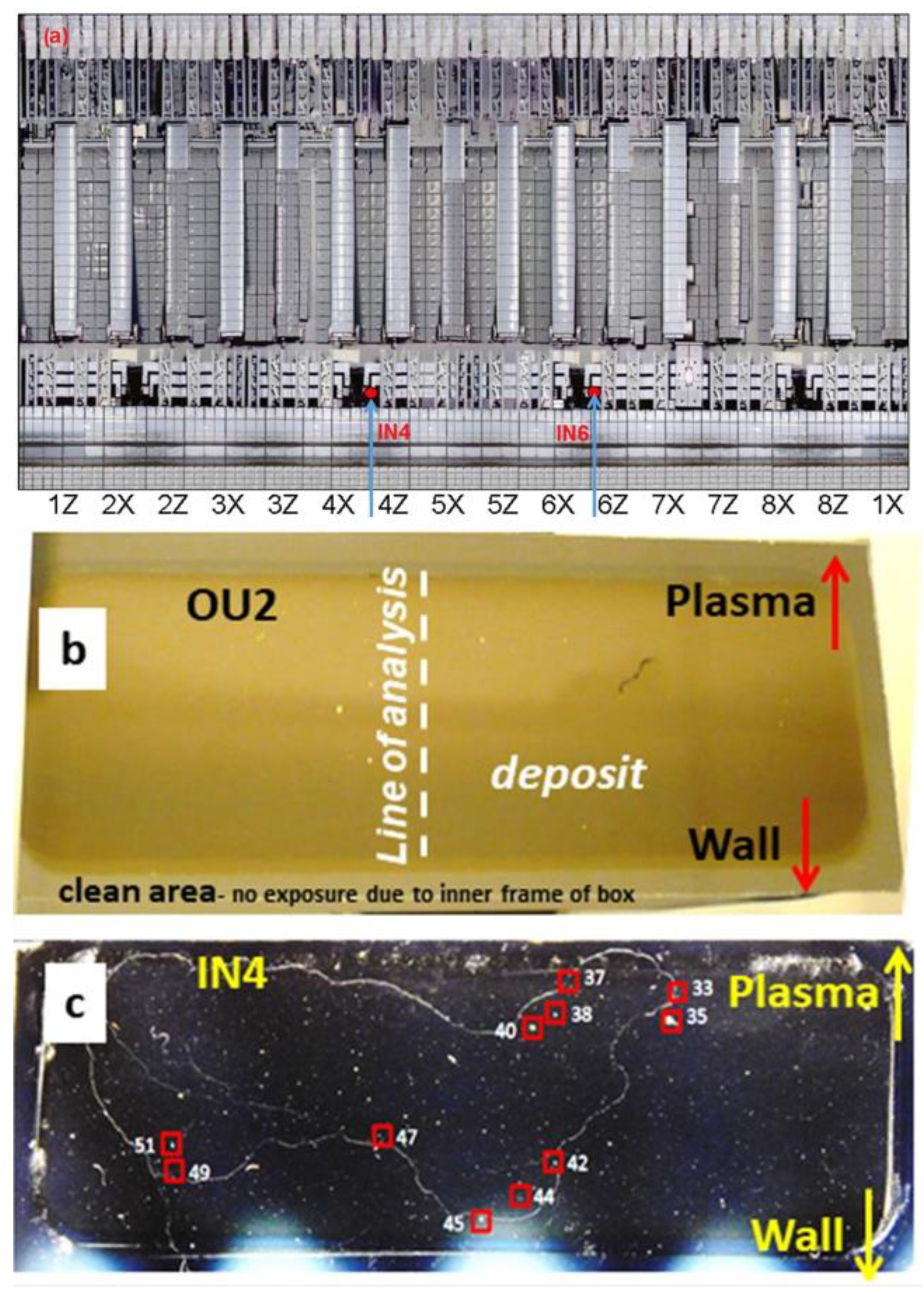
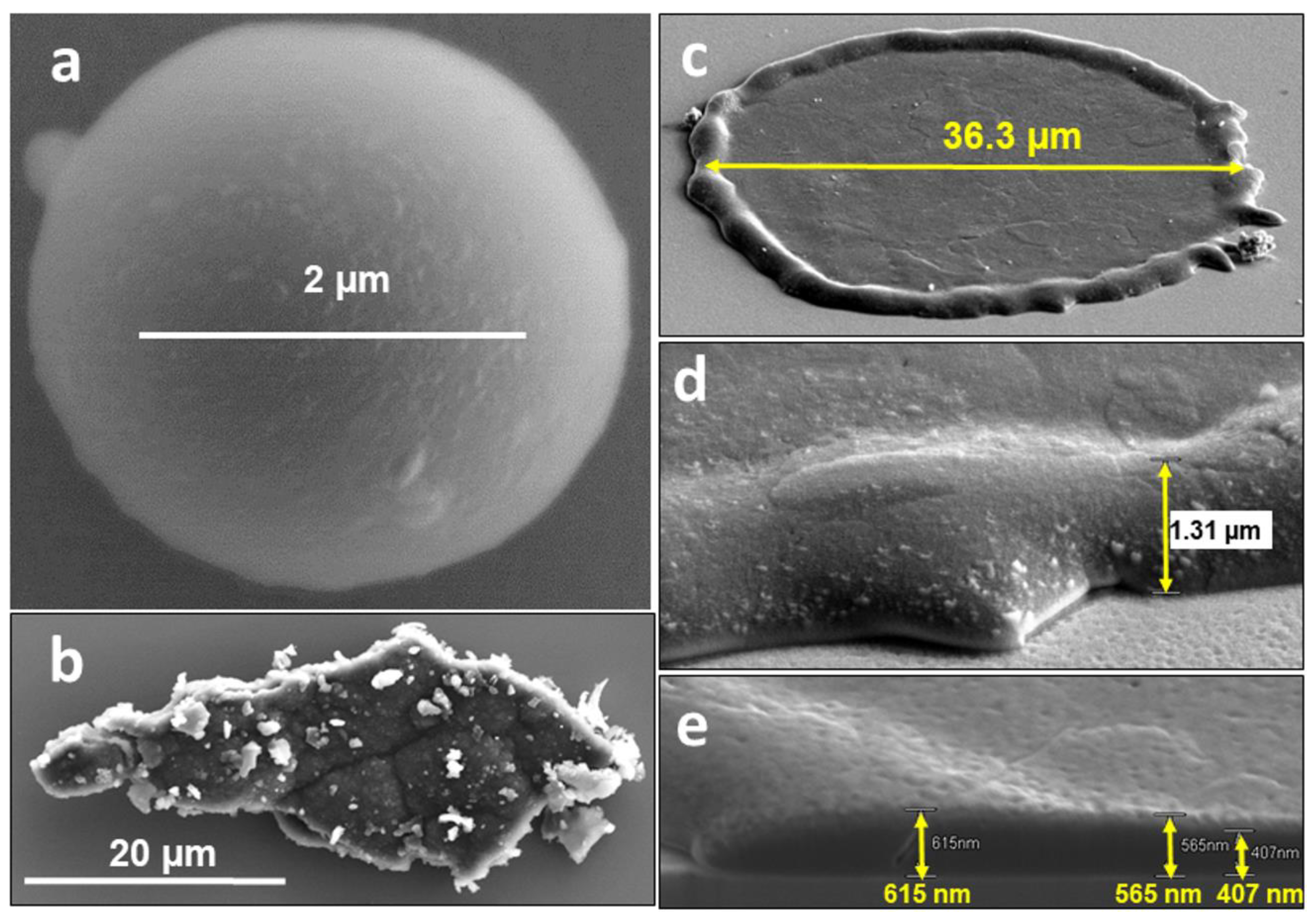
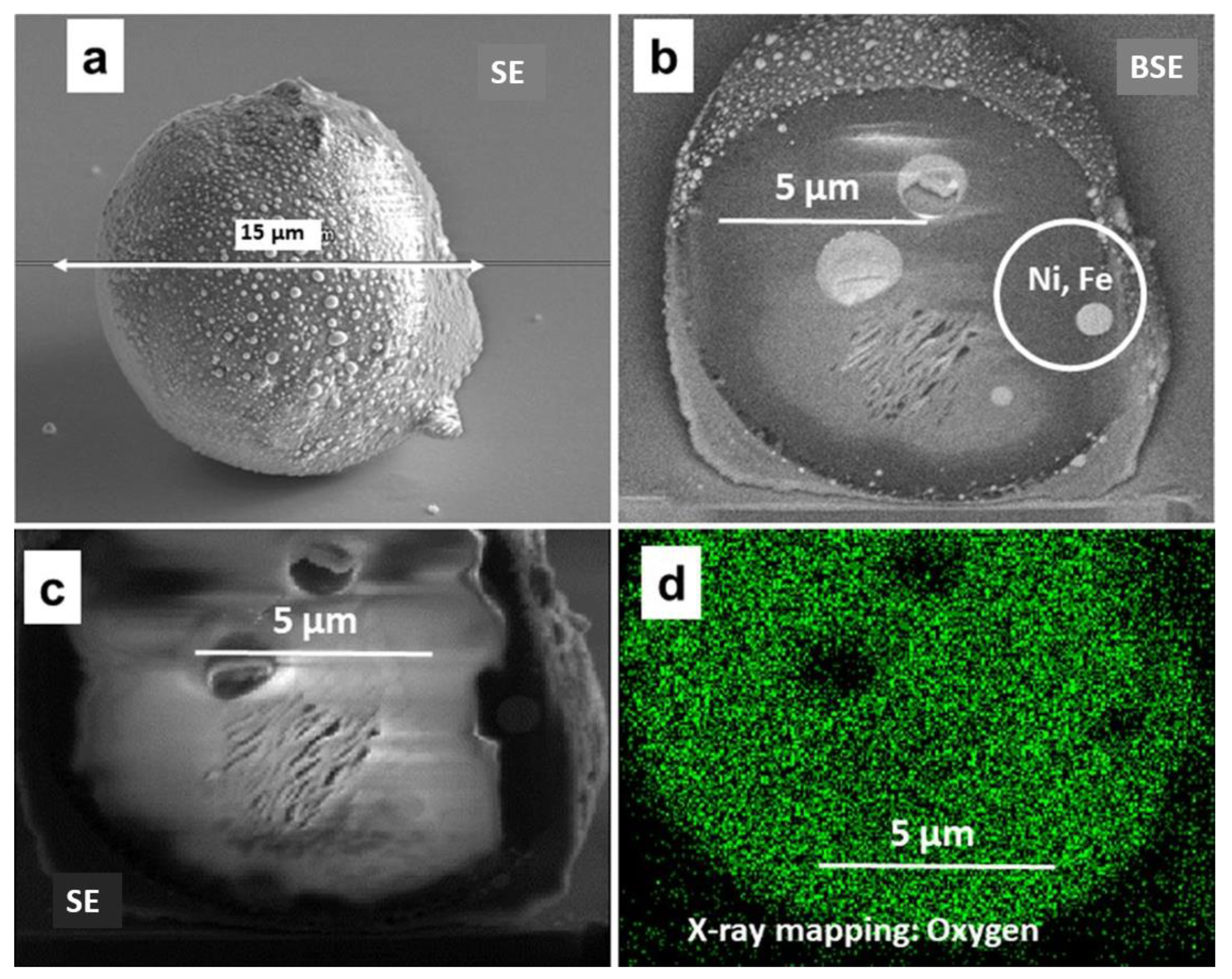


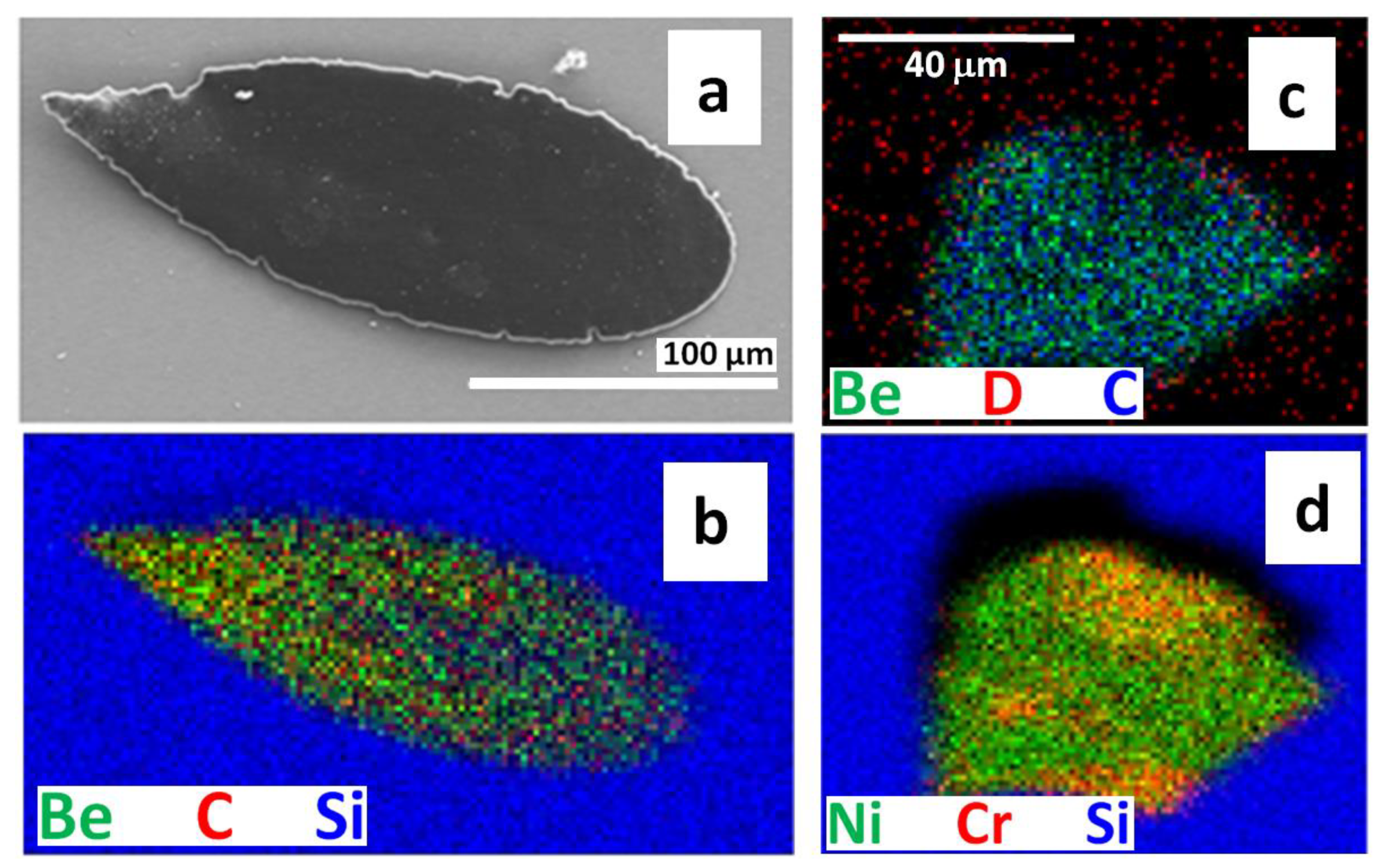

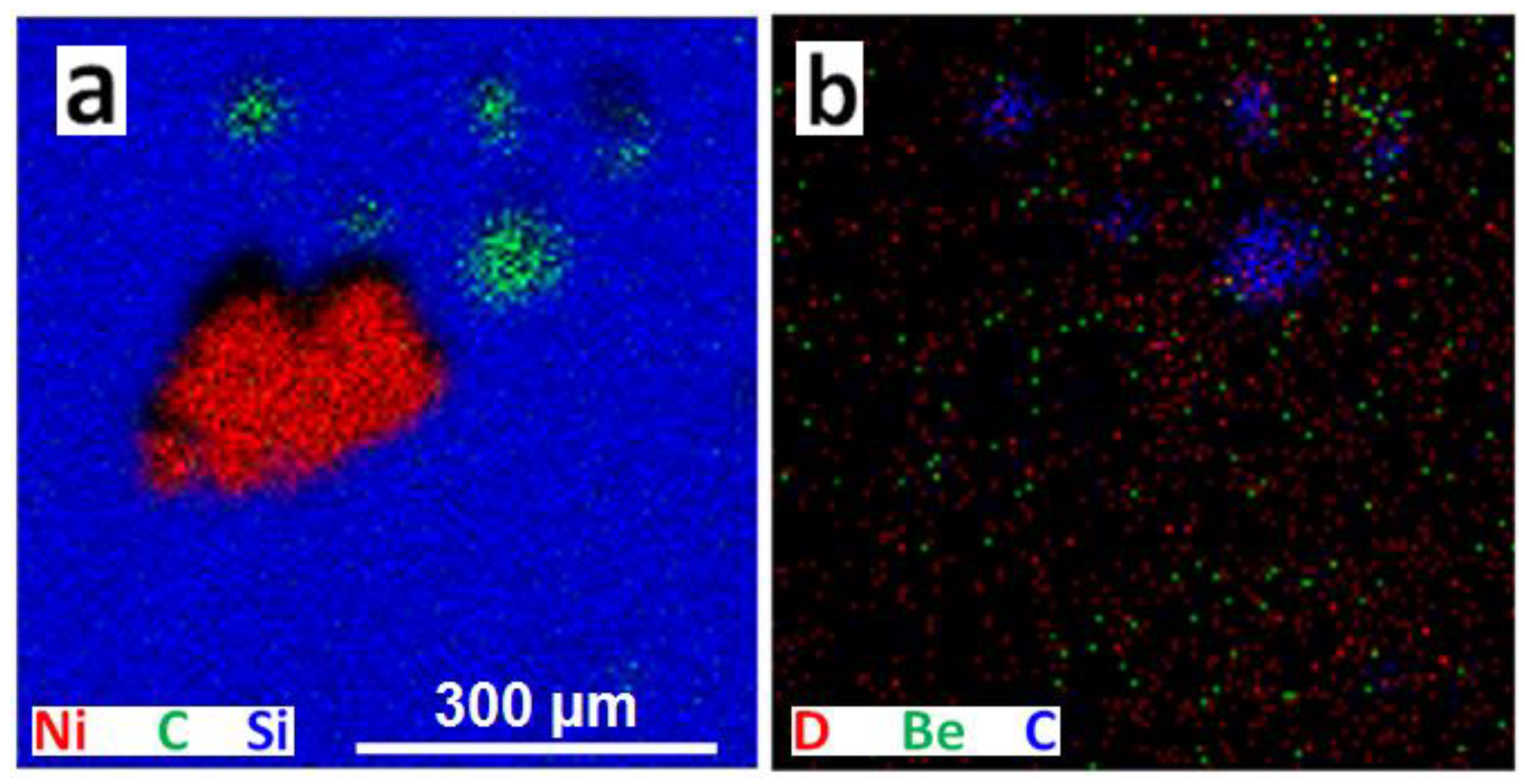


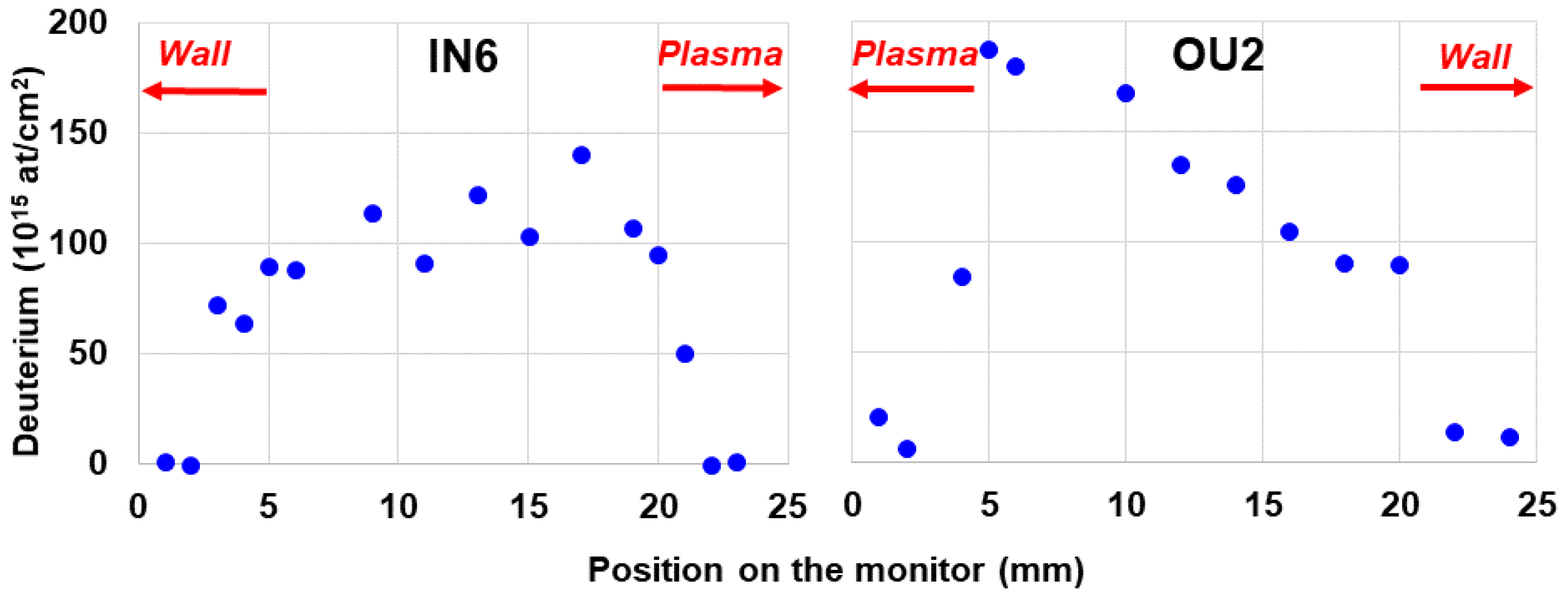
| Dust Collector/ILW Campaign | SEM/EDX Microscopy (Surface-Dust) | 3He Microscopy (Surface-Dust) | ToF HIERDA (Depth Profiles) | 3He NRA (D Distribution) |
|---|---|---|---|---|
| Inner 4 (IN4)/ILW-2 | X | X | ||
| Inner 6 (IN6)/ILW-2 | X | X | X | |
| Outer 2 (OU2)/ILW-2 | X | X | X | |
| Outer 6 (OU6)/ILW-2 | X | X | ||
| Inner 6 (IN6)/ILW-3 | X | |||
| Outer 2 (OU2)/ILW-3 | X |
Publisher’s Note: MDPI stays neutral with regard to jurisdictional claims in published maps and institutional affiliations. |
© 2022 by the authors. Licensee MDPI, Basel, Switzerland. This article is an open access article distributed under the terms and conditions of the Creative Commons Attribution (CC BY) license (https://creativecommons.org/licenses/by/4.0/).
Share and Cite
Fazinić, S.; Provatas, G.; Božičević Mihalić, I.; Tadić, T.; Rubel, M.; Grzonka, J.; Petersson, P.; Widdowson, A.; Moon, S.; Fortuna-Zaleśna, E. Dust Monitors in JET with ITER-like Wall for Diagnosis of Mobilized Particles and Co-Deposited Layers. Materials 2022, 15, 8353. https://doi.org/10.3390/ma15238353
Fazinić S, Provatas G, Božičević Mihalić I, Tadić T, Rubel M, Grzonka J, Petersson P, Widdowson A, Moon S, Fortuna-Zaleśna E. Dust Monitors in JET with ITER-like Wall for Diagnosis of Mobilized Particles and Co-Deposited Layers. Materials. 2022; 15(23):8353. https://doi.org/10.3390/ma15238353
Chicago/Turabian StyleFazinić, Stjepko, Georgios Provatas, Iva Božičević Mihalić, Tonči Tadić, Marek Rubel, Justyna Grzonka, Per Petersson, Anna Widdowson, Sunwoo Moon, and Elzbieta Fortuna-Zaleśna. 2022. "Dust Monitors in JET with ITER-like Wall for Diagnosis of Mobilized Particles and Co-Deposited Layers" Materials 15, no. 23: 8353. https://doi.org/10.3390/ma15238353
APA StyleFazinić, S., Provatas, G., Božičević Mihalić, I., Tadić, T., Rubel, M., Grzonka, J., Petersson, P., Widdowson, A., Moon, S., & Fortuna-Zaleśna, E. (2022). Dust Monitors in JET with ITER-like Wall for Diagnosis of Mobilized Particles and Co-Deposited Layers. Materials, 15(23), 8353. https://doi.org/10.3390/ma15238353





